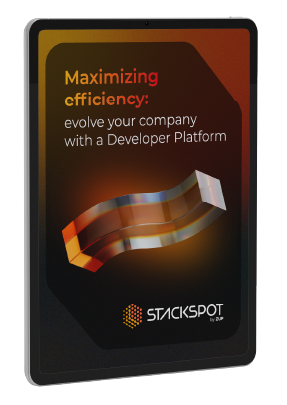The combination of platform engineering and legacy modernization provides a viable strategy for companies aiming to stay competitive in a rapidly evolving technological landscape.
In this context, software engineering professionals need sustainable solutions to address the challenges of system upgrades.
Read on for insights on platform engineering and legacy modernization.
Platform engineering and modernization
In short, modernization will work to update and implement new resources, leading to improvements in development processes, greater security, and new technologies, such as automation and artificial intelligence.
Meanwhile, platform engineering designs, develops, implements, and manages the platforms a company uses, particularly for software development. This allows other teams to run applications, store data, and perform other activities using the services and tools provided by the platform team.
Modernization challenges for engineering professionals
Are you aware that legacy maintenance may consume up to 80% of corporate IT budgets? Therefore, before starting modernization, engineering professionals should take the time to assess the issues and define the company’s objectives for updating the system.
Understanding the challenges of modernization is crucial; here are the main ones:
Legacy system complexity
After years of evolution, a once well-structured system can become outdated, plagued by complex architectures, excessive dependencies, and security vulnerabilities. This is a common outcome for legacy systems that accumulate layers of code over time, leading to high complexity and maintenance difficulties.
The platform engineering team’s starting point is to untangle this legacy to ensure sustainability, compatibility, data migration, and system integration.
New resources, such as artificial intelligence, complement development by helping to understand this legacy and recommending modernization plans.
Resistance to change
“The legacy system has worked for years; why change it?” This question may surface among engineering teams, but change is essential to meet current demands and sustain the company’s competitiveness.
Engineering professionals must embrace quick adaptation, flexibility, and agility to accept changes and actively engage in this new phase. It’s not an easy process, but ultimately valuable lessons will be learned.
Compatibility and integration
Legacy systems are often integrated with other systems, which must be monitored during modernization to avoid compatibility and integration problems.
For example, one of the biggest challenges in compatibility involves operational interruption and data inconsistency. Hence, engineering professionals are particularly challenged at this point, as they must have knowledge of both systems.
First and foremost, to facilitate this process, professionals must identify integration points, understand data dependencies, and ensure interoperability between systems.
Platform engineering simplifies integrations with other systems and services, offering developers a better experience and a more sustainable workflow.
The balance between preservation and innovation
Modernization goes hand in hand with innovation, as it involves updating a system to something more modern and advanced than its predecessor. However, there are instances where legacy and modernization must coexist, making it crucial to strike a balance between preservation and innovation.
Engineering teams must therefore stay vigilant in understanding and managing legacy systems and integrations while other applications are being modernized. Centralizing all this information will greatly benefit everyone in the project.
Uniting the CI/CD, DevOps, and QA teams
Continuous Integration (CI) and Continuous Delivery (CD) practices emphasize continuous improvement, facilitated through communication between platform engineering and DevOps teams. Collaborative efforts ensure that new software programs and updates are pre-aligned.
In practice, collaboration helps to identify challenges and map out strategies to improve operational performance. For example, a poorly configured infrastructure can hinder the timely implementation of updates and delay delivery.
Working together makes it possible to simplify processes, optimize infrastructure, and ensure better deliveries.
DevOps
In DevOps, part of the team’s job is to simplify workflows through automation.
Platform engineering professionals use tools to define the infrastructure on a daily basis, while DevOps automates the stages of the software delivery lifecycle. Despite their distinct tasks, both teams utilize tools to optimize deliveries for rapid deployments and continuous interactions.
QA
Meanwhile, the QA team will continue to identify, report, and correct problems found during testing.
With automation, the team can move away from repetitive work and craft plans to ensure quality, such as introducing standards and rules for software quality—a process supported by platform engineering.
Additionally, the CI/CD process contributes to improving software quality and fosters a positive culture of collaboration between teams.
Want to see all these topics in action? Check out our tutorial on automating API Rest testing with an AI tool.
Consume innovation, begin transformation
Subscribe to our newsletter to stay updated on the latest best practices for leveraging technology to drive business impact
Lessons from platform engineering and modernization
Focusing on infrastructure as a team is a game changer for a company. Platform engineering enhances the development cycle and the modernization process, including:
Maintenance
Previously, we discussed how legacy code is complex and challenging to understand and modify due to its outdated nature. Refactoring or rewriting this code makes it more maintainable, as it becomes easier to understand, modify, and fix.
Readability
Since legacy code is old, software documentation may be outdated, making it difficult for developers and others users to understand.
Modernizing applications improves readability with more comprehensive and up-to-date documentation. When combined with AI, it can generate documentation tailored to different user profiles. In conjunction with platform engineering, modernization facilitates historical tracking, training in new technologies, and optimization of the software’s technical documentation production.
Efficiency
Legacy code, built long ago, can be inefficient and use outdated technologies. Therefore, rewriting and optimizing the code enhances performance by reducing memory usage, execution time, and network latency.
The result is one of the key benefits of platform engineering: a more efficient system that improves application performance, deployment, and maintenance.
Bug fixing
With layers upon layers of code, bugs may have been fixed superficially without tackling their root cause.
Modernization updates the code and enables a thorough analysis of errors, providing an opportunity to fix bugs and enhance the stability and reliability of the software.
Integration with new technologies
As mentioned, integration is one of the biggest challenges in legacy modernization. After all, legacy code may not be compatible with newer frameworks, libraries, and technologies that enhance functionality and security.
Modernization enables integration and insertion of modern technologies that improve the system’s capabilities.
Empower the platform engineering team with StackSpot
Platform engineering offers essential tools for streamlining the code deployment pipeline and running automated tests. This allows developers to spend less time on routine tasks and focus on creative solutions related to the business problem.
StackSpot is an AI-first development platform that promotes speed, efficiency, and quality by learning from your company’s legacy code, documentation, and other knowledge sources. The platform has the potential to accelerate the modernization journey by supporting the development of modern applications.
Want to learn more about how StackSpot works in the modernization process? Watch the video below!
Conclusion
In short, modernization is a complex process with challenges related to people, processes, and technologies. Therefore, modern and efficient strategies are essential for managing the entire process.
This is precisely where platform engineering and modernization have great potential: platform engineering makes all the difference during the modernization process by providing tools that optimize and support developers’ work.
Combining the two strategies ensures better maintenance, readability, efficiency, bug fixing, and integration with new technologies—an excellent outcome for those looking to leave legacy in the past.
Find out more about our AI-first development platform services by contacting our team of experts.











